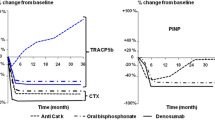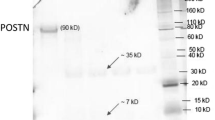Abstract.
Biochemical markers applicable to the ovariectomized rat model can provide important tools for studying the bone remodeling process in this animal model of postmenopausal osteoporosis. We describe the development and application of two biochemical markers, a C-telopeptide (of type-I collagen) enzyme-linked immunosorbent assay (ELISA) for measuring bone resorption and an osteocalcin radioimmunoassay (RIA) for measuring bone formation in rat serum. The C-telopeptide ELISA is based on an affinity purified polyclonal antibody generated against human sequence DFSFLPQPPQEKAHDGGR. The antibody epitope involves amino acid sequence, which is similar in rat and human carboxyl terminal peptide of type-I (alpha 1) collagen. Sensitivity of the ELISA was 0.3 ng/ml. The averaged intra- and interassay variation was CV <7%. Averaged dilution and spiked recoveries were 91% and 105%, respectively. The second marker developed is a synthetic peptide-based osteocalcin RIA, which does not require isolation and purification of intact osteocalcin from rat bone. Osteocalcin antiserum used in the RIA was generated in rabbits against a synthetic peptide comprising amino acids 33–49 of the rat osteocalcin sequence. The sensitivity of the RIA was 0.15 ng/ml of peptide. The averaged intra (n = 10) and interassay variations for two controls were CV <9% and 12%, respectively. The averaged dilution and spiked recoveries were 99.6%. In vivo validation of the C-telopeptide ELISA and osteocalcin RIA was performed in an ovariectomized (OVX) rat model. In 12-week-old OVX Sprague Dawley rats, the C-telopeptide and osteocalcin concentrations were approximately 65% and 40%, respectively, higher than the sham group. Estradiol repletion significantly lowered the C-telopeptide and osteocalcin concentration to the levels of the sham group. In addition, changes in serum C-telopeptide concentration correlated negatively with trabecular BMD measured by pQCT (r =−0.51, P < 0.001). In conclusion, the C-telopeptide ELISA and osteocalcin RIA exhibited required sensitivity, accuracy, and adequate discriminatory power to be used for measuring bone resorption and bone formation in the ovariectomized rat model.
Similar content being viewed by others
Author information
Authors and Affiliations
Additional information
Received: 20 August 1999 / Accepted: 5 January 2000
Rights and permissions
About this article
Cite this article
Srivastava, A., Bhattacharyya, S., Castillo, G. et al. Development and Application of a Serum C-Telopeptide and Osteocalcin Assay to Measure Bone Turnover in an Ovariectomized Rat Model. Calcif Tissue Int 66, 435–442 (2000). https://doi.org/10.1007/s002230010088
Published:
Issue Date:
DOI: https://doi.org/10.1007/s002230010088




